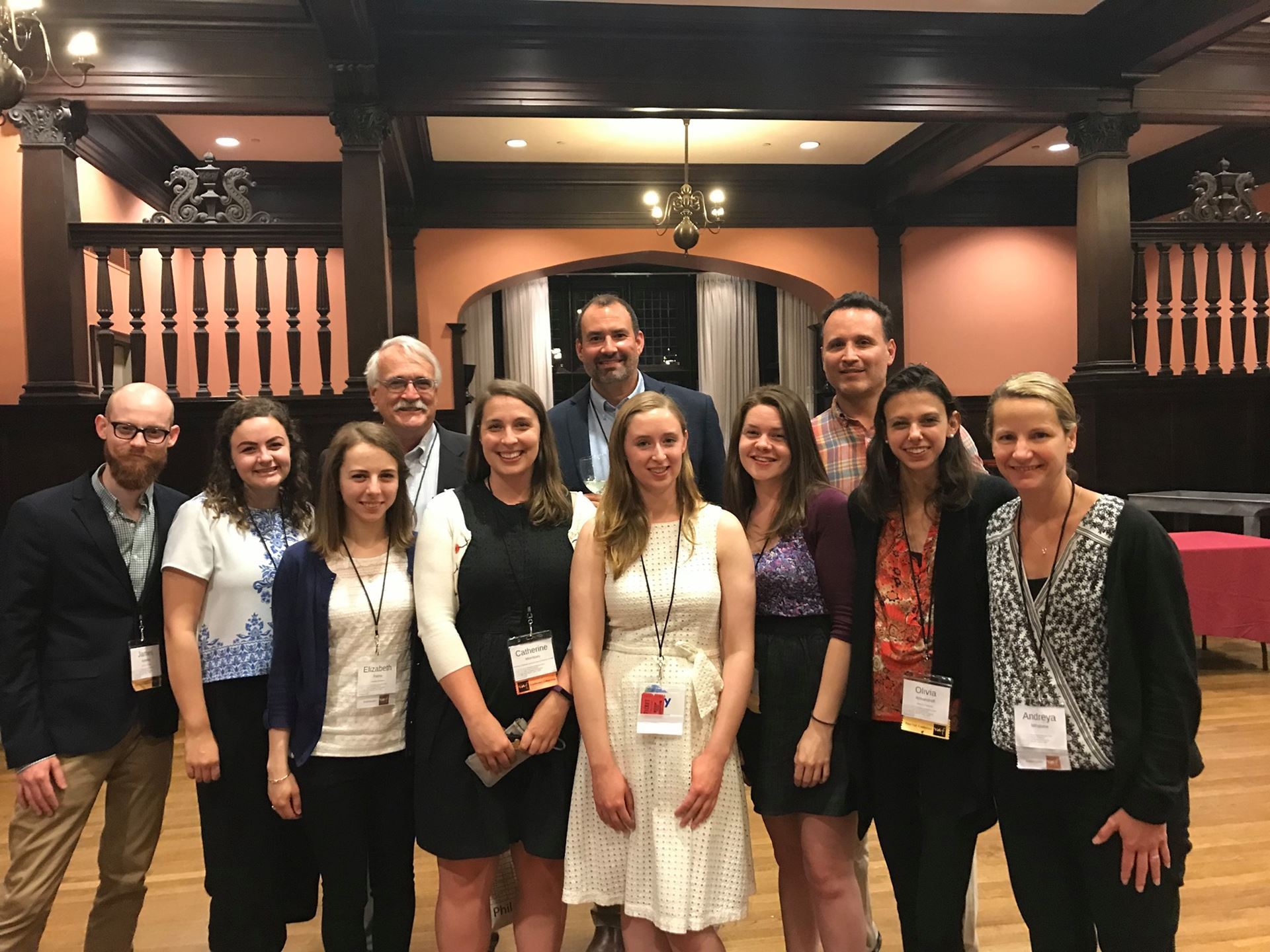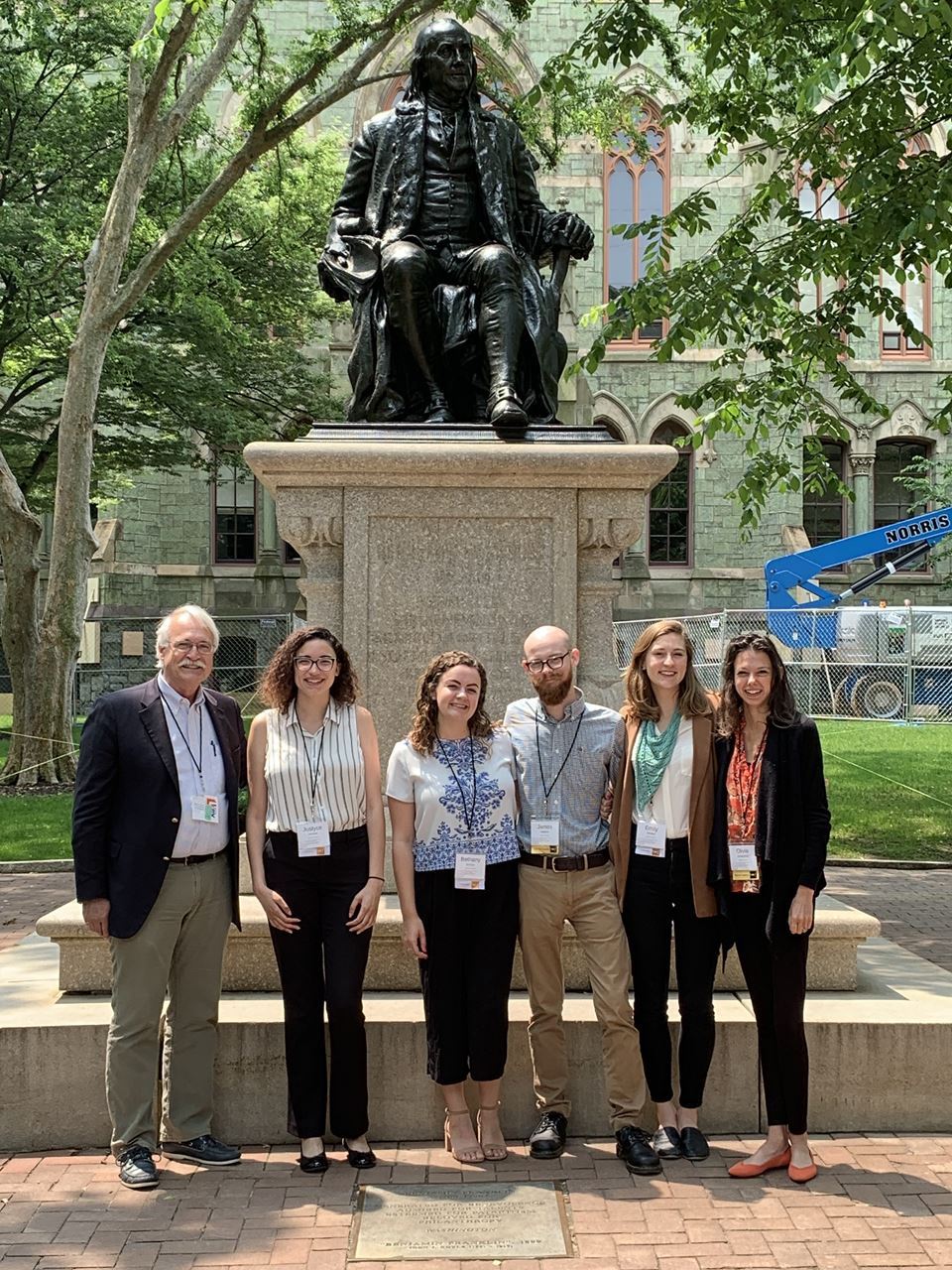
This year's VAF conference provided me with a wonderful opportunity to learn about Philadelphia's historic architecture. Friday's walking tours showcased the vibrancy and diversity of Philadelphia row houses. The row houses on tour encompassed a breadth of architectural styles and periods, reflecting the city's larger historical patterns. I found the close proximity of tiny, working-class row houses with large, high-style row houses particularly fascinating. The conference paper sessions also covered a breadth of topics pertaining to the built environment. I thought the variety of interdisciplinary approaches were refreshing and stimulating.
--Mary Fesak, American Civilization PhD Program
Despite having resided in the greater Philadelphia area for more than half my life, I had not been familiar with the history of Germantown and the historic resources located there. The collection of buildings on the bus tour, and the access we had to them, was informative and very engaging. The walking tour of center city rowhouses offered interior access to an extensive and well curated collection of this iconic Philadelphia building type, with in-depth research on each that I'm still reviewing weeks after the conference.
The paper presentations were interesting and offered different viewpoints across several historic preservation themes. In my studies, I had previously read articles by several researchers at the conference, so it was fascinating to meet them in person. As my own objectives in the field are focused on community development and public outreach, the format of the tours and presentations themselves afforded me inspiration and ideas for sharing architectural history with the public. My first VAF conference proved to be an enriching way to learn about the Philadelphia area, network with other academics and professionals, and learn from the work of preservationists across the US and beyond.
--Jamie Magee, Graduate Certificate in Historic Preservation
As a graduate student at the University of Delaware and Winterthur Museum, I spend as much time as I can exploring Philadelphia’s buildings and landscapes. When I learned that the VAF’s annual meeting would be held in Philadelphia this year, I grew excited to visit (and re-visit) sites around the city with like-minded students and scholars. As someone passionate about everyday buildings and landscapes and the stories in their construction, use, and memory, VAF provided me with an exciting and intellectually stimulating weekend that I know I won’t forget. From exploring private homes along Elfreth’s Alley to hearing the newest research in architectural history, preservation, and material culture studies, the opportunity to attend VAF as an ambassador introduced me to buildings, landscapes, friends, and mentors that will continue to inspire and inform my own research.
--Bethany J. McGlyn, Winterthur Program in American Material Culture
 The VAF Conference in Philadelphia was an ideal introduction to the organization and its important work. The meeting struck a perfect balance between tours, papers, and social opportunities.
The VAF Conference in Philadelphia was an ideal introduction to the organization and its important work. The meeting struck a perfect balance between tours, papers, and social opportunities.
With their focus on successive layers of Philadelphia’s history and built environment, the tours really helped me to see the city in ways I might not otherwise have. I learned a lot about cultural change in Germantown with a stop at an unassuming wig shop on Chelten Avenue and a conversation with the scholar who had grown up at the shop. The Concord School House and Upper Burying Ground in Germantown stood out for their ability to illuminate burial customs and the history of education in the Philadelphia area. On the second day, a look inside the houses along Elfreth’s Alley was exceptional and offered perspective on the city’s colonial roots and long history. I was further excited to explore a townhouse designed by I. M. Pei on Society Hill and talk with the home’s owner. Because of its location just across from a glorious 19th century row home on the tour, I might not have taken the time to really see Pei’s utilitarian gem. Overall, I appreciated the self-guided nature of the tours, which offered participants the freedom to explore at our own pace. Residents and occupants of buildings featured in the tour were so generous with their time, space, and knowledge.
The paper sessions made clear just how broad the field is and offered a window on the variety of research in progress. Throughout the day, I found myself wishing I could be in two or three places at once. In general, the conference offered an unparalleled opportunity to meet scholars and practitioners in the field, both more formally on paper day and by chance along tour routes, during meals, and at receptions. It was truly a rewarding experience.
The Ambassadors program is such a generous way to make the field accessible to newcomers and I am thankful to the VAF for offering these awards. Additionally, I am grateful to the conference organizers and volunteers who put so much time and energy into making the meeting a success.
--Andreya Mihaloew, Graduate Certificate in Historic Preservation
It was a privilege and treat to receive an Ambassador Award to attend this year’s VAF Conference. The final day’s paper sessions particularly stood out to me. As I made my way from presentation to presentation in the conference hall at the University of Pennsylvania, two matters in particular struck me as truly remarkable. Firstly and obviously, the presenters’ synthesis of their fieldwork and research across a wide array of time periods, regions, and cultures was impressive. Not only did I leave with my little notebook filled with notes and ideas, but I also left inspired. As someone just entering the field, watching these presentations showed me the goal toward which I am working. Someday I hope to join among those ranks of presenters. Secondly, the sense of scholarly camaraderie and genuine community stood out to me throughout the conference. People put forth thought-provoking questions and critiques in the presentations, commended each other on their work, and seemed delighted to be gathered together. Having attended my first VAF Conference now, I took those first steps into this special group of like-minded people. I am beyond grateful to have had this opportunity, and I hope to go to many more VAF Conferences in the future.
--Elizabeth Palms, Winterthur Program in American Material Culture
My first VAF conference was truly one for the books! From the moment I arrived with my classmates, I felt the welcoming sense of community that this interdisciplinary conference seems to generate, energized by the attendees' enthusiasm to unlock some of the stories of the everyday in Philadelphian architecture. Philly is a familiar city to me, but the unique opportunity for behind-the-scenes access to so many historic spaces allowed me to see the city like I never had before. Friday's self-guided tours took me into some amazing interiors, but my personal favorite was by far Arch Street Meeting House. Our group sat looking closely at graffiti carved into the backs of pews by Quaker boys in the balcony of the meeting house, which felt pretty close to stepping back in time. All in all, I am incredibly grateful to have had the chance to experience VAF for the first time, and I hope it won't be my last time attending.
--Emily Whitted, Winterthur Program in American Material Culture